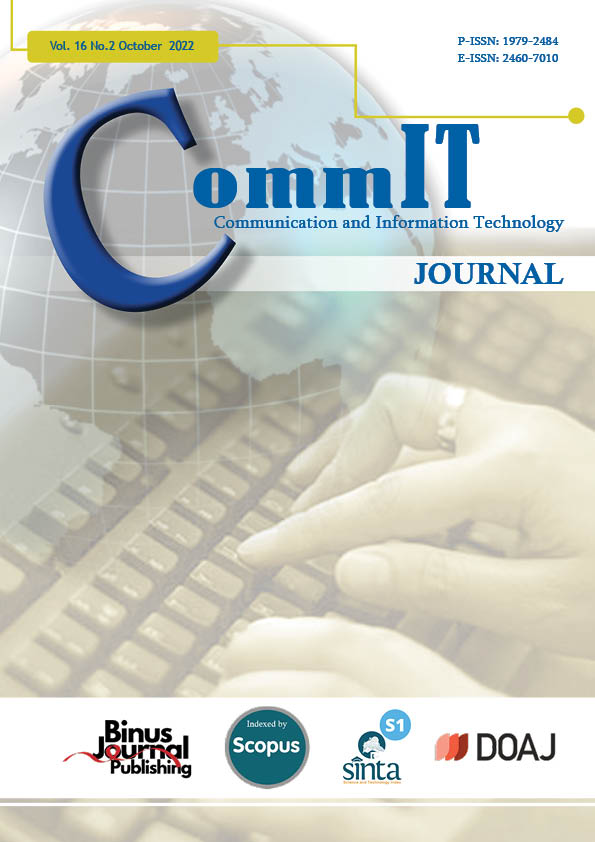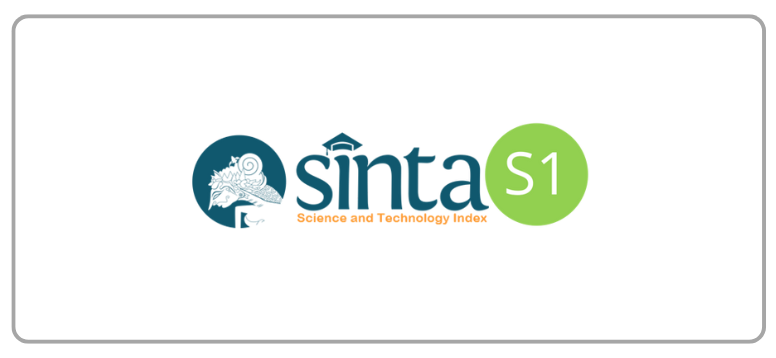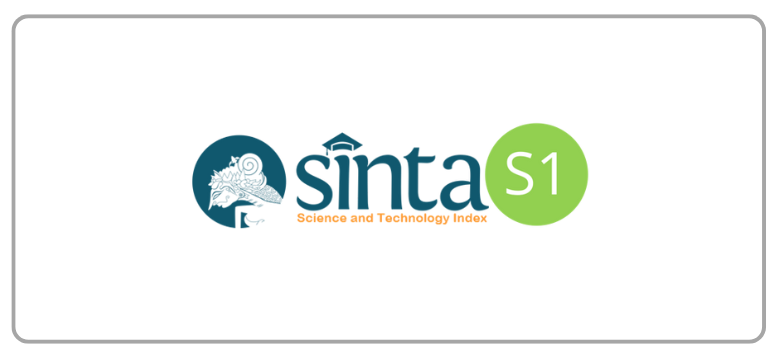Leveraging COBIT 2019 to Implement IT Governance in SME Context: A Case Study of Higher Education in Campus A
DOI:
https://doi.org/10.21512/commit.v16i2.8172Keywords:
COBIT 2019, IT Alignment, Small and Medium Enterprise (SME), Higher EducationAbstract
Achieving business and Information Technology (IT) alignment has become the aspiration of most organizations nowadays. Small and Medium Enterprises (SMEs) are not exempt as they also thrive to survive in a competitive market using IT. However, implementing all IT control and management components will be excessive, with a lack of justifiable cost-benefit for SMEs. A tailored governance system based on the specificities of SMEs is necessitated to help the organization to focus on its main objectives and strategies. By leveraging COBIT 2019 design toolkit, the researchers support Campus A in establishing healthy governance and IT management. Both qualitative and quantitative approaches are applied to select relevant governance/ management objectives. The toolkit has been designed with a semi-automated quantitative approach in which users will get scoring for each objective based on the associated value inputted for each design factor. Through a series of discussions with the management team, it concludes the governance design and recommends several improvements to increase its capability level, from the current level of 1.05 (initial stage) to the desired level of 2.33 (repeatable stage). Then, since the toolkit is practical to use, it is also rigid by design with its predefined and protected formula. To some extent, the resulting score or importance level of certain governance/management objectives is questionable and lacks justification. Flags or indicators to ‘should-have’ governance/management objectives, regardless of the organization’s size and type, will be useful to prevent the omission of essential objectives.
References
O. Olutoyin and S. Flowerday, “Successful IT governance in SMES: An application of the Technology-Organisation-Environment theory,†South African Journal of Information Management, vol. 18, no. 1, pp. 1–8, 2016.
J. Devos, H. Van Landeghem, and D. Deschoolmeester, “IT governance in SMEs: A theoretical framework based on the outsourced information systems failure,†in 3rd European Conference on Information Management and Evaluation. Sweden: Academic Conferences ltd, Sept. 17–18, 2009, pp. 132–142.
F. Mijnhardt, T. Baars, and M. Spruit, “Organizational characteristics influencing SME information security maturity,†Journal of Computer Information Systems, vol. 56, no. 2, pp. 106–115, 2016.
A. M. Stjepi´c, M. Peji´c Bach, and V. Bosilj Vukˇsi´c, “Exploring risks in the adoption of business intelligence in SMEs using the TOE framework,†Journal of Risk and Financial Management, vol. 14, no. 2, pp. 1–18, 2021.
J. Natovich, “Vendor related risks in IT development: A chronology of an outsourced project failure,†Technology Analysis & Strategic Management, vol. 15, no. 4, pp. 409–419, 2003.
N. Shankar, “Role of global economic policy uncertainty on firms participation in innovation and new product introductions: An empirical study in African SMEs,†Transnational Corporations Review, vol. 12, no. 4, pp. 360–378, 2020.
ISACA, Designing an information and technology governance solution. ISACA, 2018.
R. F. Frogeri, D. J. Pardini, A. M. P. Cardoso, L. A´ . Prado, F. P. Piurcosky, and P. d. S. P. Junior, “IT governance in SMEs: The state of art,â€International Journal of IT/Business Alignment and Governance (IJITBAG), vol. 10, no. 1, pp. 55–73, 2019.
T. Huygh and S. De Haes, “Exploring the research domain of it governance in the SME context,†in Start-ups and SMEs: Concepts, methodologies, tools, and applications. IGI Global, 2020, pp. 1606–1622.
I. Scalabrin Bianchi, R. Dinis Sousa, and R. Pereira, “Information technology governance for higher education institutions: A multi-country study,†Informatics, vol. 8, no. 2, pp. 1–28, 2021.
M. Q. Y. He, K. Peiris, and M. Myers, “IT governance strategies for SMEs in the Fourth Industrial Revolution,†in PACIS 2019, X’ian, China, 2019.
F. Salehi, B. Abdollahbeigi, and S. Sajjady, “Impact of effective IT governance on organizational performance and economic growth in Canada,†Asian Journal of Economics, Finance and Management, vol. 3, no. 2, pp. 14–19, 2021.
ISACA, COBIT®2019 framework: Introduction & methodology. ISACA, 2018.
A. E. Asmah and M. Kyobe, “Towards an integrative theoretical model for examining IT governance audits,†in Proceedings of the 11th International Conference on Theory and Practice of Electronic Governance, Galway, Republic of Ireland, April 4–6 2018, pp. 18–22.
ISACA, Introducing COBIT 2019: Executive summary. ISACA, 2018.
A. C. Amorim, M. M. Da Silva, R. Pereira, and M. Gonc¸alves, “Using agile methodologies for adopting cobit,†Information Systems, vol. 101, pp. 1–16, 2021.
ISACA, Introducting COBIT 2019: Major differences with COBIT 5. ISACA, 2018.
M. S. Dar, S. Ahmed, and A. Raziq, “Small and medium-size enterprises in Pakistan: Definition and critical issues,†Pakistan Business Review, vol. 19, no. 1, pp. 46–70, 2017.
A. Khodakivska, “Measuring jobs from micro, small, and medium-size enterprises financed by IFC client financial institutions,†The World Bank, Tech. Rep., 2013.
K. Peffers, T. Tuunanen, M. A. Rothenberger, and S. Chatterjee, “A design science research methodology for information systems research,†Journal of Management Information Systems, vol. 24, no. 3, pp. 45–77, 2007.
K. Peffers, T. Tuunanen, and B. Niehaves, “Design science research genres: Introduction to the special issue on exemplars and criteria for applicable design science research,†European Journal of Information Systems, vol. 27, no. 2, pp. 129–139, 2018.
S. Ebneyamini and M. R. Sadeghi Moghadam, “Toward developing a framework for conducting case study research,†International Journal of Qualitative Methods, vol. 17, pp. 1–11, 2018.
K. Thoring, R. Mueller, and P. Badke-Schaub, “Workshops as a research method: Guidelines for designing and evaluating artifacts through workshops,†in Proceedings of the 53rd Hawaii International Conference on System Sciences, Grand Wailea, Hawaii, Jan. 7–10, 2020.
Y. K. Singh, Fundamental of research methodology and statistics. New Age International, 2006.
L. Englbrecht, S. Meier, and G. Pernul, “Towards a capability maturity model for digital forensic readiness,†Wireless Networks, vol. 26, no. 7, pp. 4895–4907, 2020.
E. Elue, “Effective capability and maturity assessment using COBIT 2019,†2020. [Online]. Available: https://bit.ly/3cCBAfs
SFIA, “The global skills and competency framework for the digital world,†2018. [Online]. Available: https://sfia-online.org/en/sfia-7
S. De Haes, W. Van Grembergen, A. Joshi, and T. Huygh, “Enterprise governance of information technology: Achieving alignment and value in digital organizations,†in Management for professionals (MANAGPROF). Springer, 2020.
T. Papadopoulos, K. N. Baltas, and M. E. Balta, “The use of digital technologies by small and medium enterprises during COVID-19: Implications for theory and practice,†International Journal of Information Management, vol. 55, pp. 1–4, 2020.
A. Joshi, J. Benitez, T. Huygh, L. Ruiz, and S. De Haes, “Impact of it governance process capability on business performance: Theory and empirical evidence,†Decision Support Systems, vol. 153, pp. 1–12, 2022.
L. Raymond, F. Bergeron, A.-M. Croteau, and S. Uwizeyemungu, “Determinants and outcomes of IT governance in manufacturing SMEs: A strategic IT management perspective,†International Journal of Accounting Information Systems, vol. 35, pp. 1–15, 2019.
H. C. C. d. Silva, D. S. d. Silveira, J. S. Dornelas, and H. S. Ferreira, “Information technology governance in small and medium enterprisesa systematic mapping,†JISTEM-Journal of Information Systems and Technology Management,vol. 17, pp. 1–16, 2019.
W. S. Castellanos, “Impact of the Information Technology (IT) governance on business- IT alignment,†Ph.D. dissertation, Pontificia Universidad Catolica del Peru-CENTRUM Catolica (Peru), 2020.
A. Levstek, T. Hovelja, and A. Pucihar, “IT governance mechanisms and contingency factors: Towards an adaptive IT governance model,†Organizacija, vol. 51, no. 4, pp. 286–310, 2018.
M. Martinsuo and T. Luomaranta, “Adopting additive manufacturing in SMEs: Exploring the challenges and solutions,†Journal of Manufacturing Technology Management, vol. 29, no. 6, pp. 937–957, 2018.
Downloads
Published
How to Cite
Issue
Section
License
Copyright (c) 2022 Diana Utomo, Mahaning Wijaya, Suzanna, Efendi

This work is licensed under a Creative Commons Attribution-ShareAlike 4.0 International License.
Authors who publish with this journal agree to the following terms:
a. Authors retain copyright and grant the journal right of first publication with the work simultaneously licensed under a Creative Commons Attribution License - Share Alike that allows others to share the work with an acknowledgment of the work's authorship and initial publication in this journal.
b. Authors are able to enter into separate, additional contractual arrangements for the non-exclusive distribution of the journal's published version of the work (e.g., post it to an institutional repository or publish it in a book), with an acknowledgment of its initial publication in this journal.
c. Authors are permitted and encouraged to post their work online (e.g., in institutional repositories or on their website) prior to and during the submission process, as it can lead to productive exchanges, as well as earlier and greater citation of published work.
Â
USER RIGHTS
All articles published Open Access will be immediately and permanently free for everyone to read and download. We are continuously working with our author communities to select the best choice of license options, currently being defined for this journal as follows: Creative Commons Attribution-Share Alike (CC BY-SA)




















